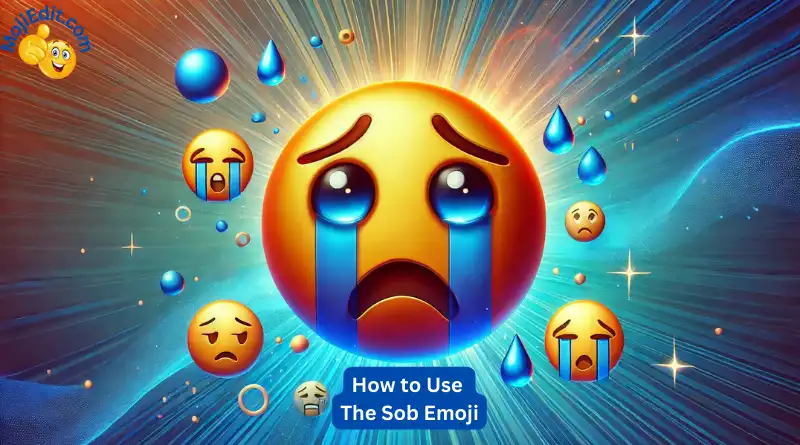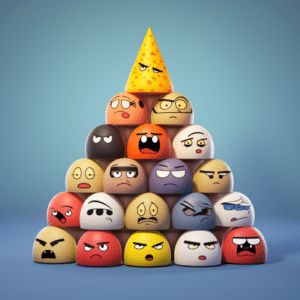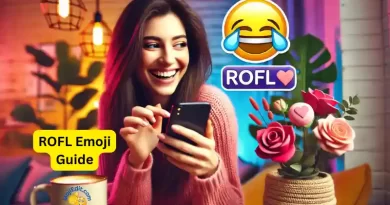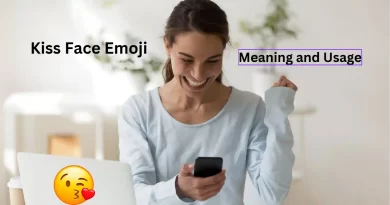Sob Emoji Meanings and Variations
Sob Emoji Meaning And Samples
Emojis have evolved into a universal language of the digital age, with the sob emoji being one of its most expressive symbols. The sob emoji meaning and different styles can convey an array of emotions, from deep sadness to overwhelming joy.
In this guide, we’ll explore the history and use of emojis, including their meanings in communication and etiquette related to sob emoji. We’ll discuss everything from how these mysterious symbols relate to our daily communication habits to the etiquette surrounding their use.
You’ll learn about popular emojis used for expressing sadness or empathy alongside the sob emoji. Furthermore, we’ll explore generational differences in interpretation – particularly how thumbs-up emoji reactions are viewed differently across age groups.
We will also provide practical tips on using keyboard shortcuts for your favorite emojis and navigating potential pitfalls in emotional intent when using them. So join us as we decode the complex language of emojis, focusing on understanding various aspects related to ‘sob emoji meaning and different styles’.
Table of Contents:
- Decoding the World of Emojis
- Understanding Emoji Meanings
- Generational Differences in Emoji Usage
- Emojis Beyond Faces – A Look at Objects, Animals & More
- Navigating Potential Pitfalls in Emoji Communication
- FAQs in Relation to Sob Emoji Meaning and Different Styles
- Conclusion
Decoding the World of Emojis
Welcome to the captivating universe of emojis.
Their rise in popularity has been meteoric, with over 60% of folks over 35 claiming to be “frequent” emoji users. In fact, Oxford Dictionaries crowned the “face with tears of joy” emoji as their word for 2015.
The Rise of Emoji Culture
In the digital epoch, emojis have progressed beyond simply being appealing icons on our screens.
They’ve become an essential part of how we communicate online – breaking down language barriers and adding emotional intent where regular text might fall flat.
The Artful Dance that is Emoji Etiquette
Decoding emoji symbols can be tricky terrain to navigate.
Sometimes it’s hard not to get carried away by those overly expressive emoji faces or even the thumbs-up reaction. It’s important to use them in the right context to avoid miscommunication.
This brings us closer to understanding the meanings behind popular emojis like the sobbing face and others alike.
We’re about to dive deep into decoding some confusing faces and other intriguing aspects surrounding popular Gen Z favorites. Get ready.t
Understanding Sob Emoji Meanings
| Emoji | Description | Meaning | How to Type |
|---|---|---|---|
| 😢 | Crying Face | Indicates sadness or disappointment | :'( or ;'( |
| 😭 | Loudly Crying Face | Represents intense sadness or heartbreak | ;_; or ;-; |
| 😔 | Pensive Face | Conveys a sense of sadness, disappointment, or regret | :/ or :-/ |
| 😞 | Disappointed Face | Shows a feeling of disappointment or unhappiness | :[ or :-[ |
| 😣 | Persevering Face | Indicates a combination of determination and exhaustion | –– or –– |
| 😪 | Sleepy Face | Represents tiredness or sleepiness | zzz or -_- |
| 😓 | Downcast Face with Sweat | Depicts stress, relief, or discomfort | :S or :-S |
| 😥 | Sad but Relieved Face | Conveys mixed emotions of sadness and relief | :’) or :-‘) |
Diving into the world of emojis, we encounter a sea of faces and symbols with hidden meanings. But don’t worry. We’re here to help you decode these mysterious icons, focusing primarily on those related to sadness and empathy such as the sob emoji.
The Sob Emoji – More Than Just Tears
At first glance, emojis may not appear to be what they actually are.
Other Emojis Expressing Sadness or Empathy
Let’s explore some emojis that convey sadness or empathy:
- The slight-smile face: This emoticon subtly expresses mild amusement or light-hearted sarcasm – a perfect tool when words fail us during digital conversations.
- The thumbs-up used ironically when feeling low: It’s a bit paradoxical, but sometimes humor helps us cope better.
It’s essential to consider the context and emotions behind each emoji when sending them. Some emojis have developed sexual innuendos or confusing faces that may not align with their original meanings.
Finally, once you’re accustomed to the popular emoji symbols and their meanings, you’ll find yourself effortlessly navigating through this fascinating universe filled with colorful expressions.
Generational Differences in Sob Emoji Usage
Digging into the world of emojis, we find intriguing differences across generations.
A recent survey suggests that for those aged 16-29, using certain emoji symbols like the thumbs-up ironically labels you as “officially old”.
The Thumbs-Up Emoji – A Symbol Misunderstood?
Thumbs up or down? That’s a question many ask when it comes to this popular emoji gen.
This universal sign of approval has been decoded differently by various age groups. Some view the thumbs-up emoji reaction as passive-aggressive or even ironic.
If you’re a regular texter with Gen Z recipients, understanding their unique interpretation can save your messages from being misunderstood. It’s proper emoji etiquette after all.
From Slight-Smile Face to Crying-Laughing – Decoding Gen Z’s Favorites
Moving on from confusing faces and mysterious symbols related to older generation favorites – let’s dive into what makes Gen Z tick in terms of emoticons and smileys.
The blushing smiley circled its way around texts while crying-laughing took over social media platforms.
Remember though: overly expressive emojis might not always hit home with younger audiences.
With each new wave of users come fresh interpretations and uses for these digital expressions.
So if your aim is connecting better through texting or just keeping up-to-date with the latest trends among younger folks – decoding their favorite emojis should be high on your list.
Ready now?
Let us explore beyond facial expressions towards other categories such as objects & animals.
Emojis Beyond Faces – A Look at Objects, Animals & More
We’ve covered the basics of popular emojis and their meanings, but did you know there’s a whole world beyond just faces?
Keyboard Shortcuts for Popular Emojis
The realm of emojis extends far past simple facial expressions. You can find everything from animals to objects in this digital language.
This guide provides an extensive list of keyboard shortcuts for popular emojis. It’s perfect for those who want quick access to their favorites without scrolling through pages.
Now let’s dive into some examples:
A red heart emoji ❤ could express love or affection towards someone or something.
Pizza slice 🍕 – Who doesn’t love pizza? This one often pops up in conversations about food or dinner plans.
However, it isn’t all fun and games with these seemingly innocent icons. Some emojis have developed sexual innuendos over time due to certain associations made by users. For instance:
- The eggplant emjoi 🍆 has become synonymous with male anatomy.
- The peach 🍑 now holds connotations related to female body parts.
This shift demonstrates how user interpretations can dramatically change an emoji’s meaning over time. While using such symbols may seem harmless initially, they carry potential risks if misunderstood within different contexts. In essence: Be mindful. The power of interpretation lies ultimately with your audience.
Navigating Potential Pitfalls in Emoji Communication
Navigating the realm of emojis requires an understanding of potential misinterpretations that may arise from their ambiguous meanings, and thus it is essential to ensure your intended emotion is effectively expressed through your selection.
The key is ensuring your emotional intent is accurately conveyed through your chosen symbols.
When Emojis Take a Sexual Turn
Innocent-looking emojis acquiring sexual connotations over time is not uncommon. It’s part and parcel of how language evolves – even when that ‘language’ involves small digital images.
Oxford Dictionaries presents an interesting exploration into this phenomenon.
Emoji Etiquette: Avoiding Misunderstandings
To navigate these tricky waters without causing offense or misunderstanding, consider following some simple guidelines:
- Be mindful about who you’re communicating with – age group, relationship status, etc., matter greatly in interpreting emoji meanings related to developed sexual innuendos.
- Avoid using any potentially offensive or inappropriate ones unless you’re sure they’ll be understood correctly by the recipient.
Ensuring Positive Emotional Context in Your Messages
Maintaining a positive emotional context while sending messages laden with emoticons isn’t always easy but certainly doable if one follows certain principles:
- Pick up on cues from previous conversations: If someone uses lots of thumbs-up reactions or blushing smiley circled faces, text them back. This shows mutual understanding and respect for each other’s preferred communication styles. Remember though, don’t use the thumbs-up emoji ironically as younger generations might misinterpret its meaning.
Key Takeaway: Sob Emoji
– Personal experiences or anecdotes can add a personal touch to your writing, but make sure to keep it relevant and relatable to your readers.
– Avoid any form of bias towards a specific brand, product, or service, because we want to keep things fair and unbiased.
– While emojis are a fun way to express ourselves, it’s important to understand their meanings and use them appropriately.
– If you’re not sure what an emoji means, there are plenty of resources available to help you decode emoji symbols.
– The thumbs-up emoji is a popular choice for expressing approval or agreement, but be careful not to use it ironically and confuse your readers.
– Emojis can add a playful touch to your messages, but make sure you’re aware of the emotional context they convey.
– Some emojis have developed sexual innuendos over time, so be cautious when using them in certain contexts.
– Confusing faces like the slight-smile face can be tricky to interpret, so make sure your emotional intent is clear.
– Oxford Dictionaries even added the “Face with Tears of Joy” emoji as the Word of the Year in 2015, showing just how popular emojis have become.
– If you’re a regular texter, it’s important to stay up-to-date with the latest emoji trends and meanings.
Conclusion
Understanding the sob emoji meaning and different styles is crucial for effective digital communication.
Decoding the world of emojis helps us navigate generational differences in usage, avoid pitfalls, and ensure positive emotional context in our messages.
Emojis have become a universal language, adding emotional context to text-based conversations.
Whether expressing deep sadness or overwhelming joy, emojis play a significant role in conveying emotions accurately. To make these emojis show up in text, you can either use the specific keyboard emojis on your device or type their corresponding textual representations. The textual representations are usually enclosed in colons (:) or brackets (<>) and can vary across different platforms. If a specific representation doesn’t show up as an emoji, it will still convey the intended meaning.
Remember that emojis are not always a perfect substitute for expressing complex emotions, so it’s important to consider the context and use them appropriately to ensure effective communication.
Frequently Asked Questions and Answers
The sob emoji 😭, also known as the loudly crying face, typically represents deep sadness, intense frustration, or overwhelming emotion. It’s used to convey feelings of heartbreak, grief, or extreme disappointment.
Use the loudly crying face emoji 😭 for expressing strong emotions such as deep sadness, grief, or even overwhelming joy. The crying face emoji 😢 is better suited for milder sadness or disappointment.
Use the sob emoji 😭 when you want to express strong feelings of sadness, frustration, or when something deeply affects you emotionally. It’s perfect for moments of heartbreak, overwhelming joy, or even extreme laughter.
People often use the sob emoji 😭 ironically to exaggerate minor frustrations or annoyances humorously. This usage adds a dramatic flair to otherwise mundane complaints or situations.
Yes, emojis like the crying face emoji 😢, pensive face emoji 😔, and disappointed face emoji 😞 express sadness or disappointment but with less intensity than the sob emoji 😭.







